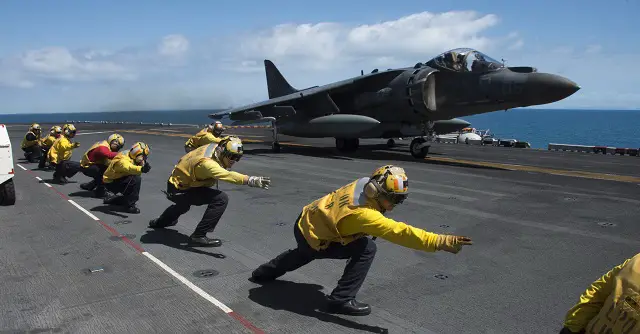|
USS Wasp to Become First Ship to Deploy with an Embarked F-35B Squadron
|
||
| .a | ||
|
||
|
|
|||
|
USS Wasp F-35B Operations
|
|||
|
|
|||
|
The F-35B is the world’s first supersonic short take-off, vertical landing (STOVL) fighter and is set to become the new standard across the amphibious fleet eventually replacing the AV-8B Harrier and F/A-18 Hornet. STOVL aircraft are fixed-wing aircraft that are able to take off from a short runway and land vertically like a helicopter. They can also take off vertically if they don’t have a heavy payload.
The STOVL capability of F-35B provides forward-deployed combatant commanders with more flexible basing options. In particular, when this aircraft deploys from LHDs, or America class LHAs, squadrons will be able to reach targets inaccessible from shore-based runways. Which is to say that if the target is too far away by flight alone commanders have the option to move a U.S. Navy Surface Force ship closer via sea and then launch aircraft to the target from there. |
|||
|
|
|||
 CORAL SEA (Aug. 22, 2017) An AV-8B Harrier, assigned to the “Tomcats” of Marine Attack Squadron (VMA) 311, takes off from the flight deck of the amphibious assault ship USS Bonhomme Richard (LHD 6). VMA-311 concludes its “farewell tour” with the Bonhomme Richard Expeditionary Strike Group (BHR ESG) and the 31st Marine Expeditionary Strike Group (MEU) as the ESG transitions to F-35B Lightning II Joint Strike Fighters in the winter of 2017. Bonhomme Richard, flagship of the BHR ESG, is operating in the Indo-Asia Pacific region to enhance partnerships and be a ready-response force for any type of contingency. (U.S. Navy photo by Mass Communication Specialist 2nd Class Cameron McCulloch/Released) CORAL SEA (Aug. 22, 2017) An AV-8B Harrier, assigned to the “Tomcats” of Marine Attack Squadron (VMA) 311, takes off from the flight deck of the amphibious assault ship USS Bonhomme Richard (LHD 6). VMA-311 concludes its “farewell tour” with the Bonhomme Richard Expeditionary Strike Group (BHR ESG) and the 31st Marine Expeditionary Strike Group (MEU) as the ESG transitions to F-35B Lightning II Joint Strike Fighters in the winter of 2017. Bonhomme Richard, flagship of the BHR ESG, is operating in the Indo-Asia Pacific region to enhance partnerships and be a ready-response force for any type of contingency. (U.S. Navy photo by Mass Communication Specialist 2nd Class Cameron McCulloch/Released) |
|||
|
|
|||
|
“[Wasp’s homeport shift] ensures that our most technologically-advanced air warfare platforms are forward deployed,” said Wasp Commanding Officer Capt. Andrew Smith. “Our capabilities, paired with the F-35B Joint Strike Fighter, increases our Navy’s precision strike capabilities within the 7th Fleet region. Wasp will help America’s commitment to the maritime security and stability in the Indo-Asia-Pacific.”
Together forward-deployed amphibious ships like Wasp and embarked Marine Expeditionary Units (MEU) like that of their 31st MEU, will form U.S. Pacific Command‘s premier crisis response force. Together, the U.S. Navy-Marine Corps team has the capability to conduct stability operations or deliver disaster relief at a moment’s notice. |
|||








